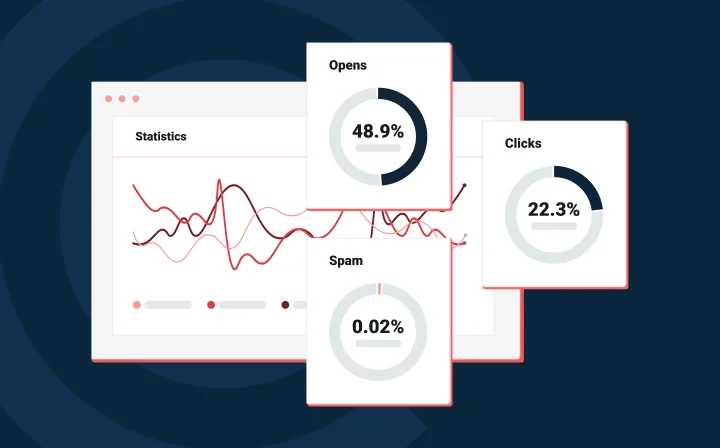Deliverability
How to improve your email deliverability for the future of email

Deliverability

When it comes to email marketing, many senders focus solely on their delivery rates. But here’s the catch: a high delivery rate doesn’t always translate to great deliverability.
At 2024’s Email Camp: MessageMania, industry expert Laura Atkins highlighted the rapid changes in email deliverability and the need for marketers to adapt. Building on these insights and our latest research, we’ve compiled this guide to help you navigate the complex landscape of email delivery and deliverability in 2025 and beyond.
Don’t let the names fool you. Email Delivery and Email Deliverability are two different things:
A good delivery rate doesn’t always mean good deliverability but our 2025 state of email deliverability report shows that 50.9% of respondents confuse delivery for deliverability, the percent of email that reach the inbox.
An email program is one of the most valuable tools at an organization’s disposal as it can help you achieve a high deliverability rate, which is the rate at which your email is successfully delivered to your target audience’s inbox. However, if done poorly, your program may result in low deliverability rates, fewer customers, and delayed orders or services.
Every single one of us has the opportunity to create the future of deliverability, and I say this from experience.

As the email landscape evolves, so to do the challenges. Email is fundamentally changing, and this brings us to an inflection point in the evolution of email. The chaos, the questions, the legislation, and the new technologies like AI only highlight the importance of email deliverability. And inboxes have been getting involved.
In 2024 Gmail and Yahoo began implementing major changes, holding bulk senders to deliverability standards.
What Yahoo and Google really did was just add enforcement, so senders stick to best practices. Because of this, we’ve seen an 11% increase in DMARC adoption, which was historically minimal. Here’s how email authentication implementation looks according to State of email deliverability 2025:
| DKIM and SPF usage | DMARC adoption |
|---|---|
| 58.5% use DKIM, 55.4 % use SPF in 2023 | 42.5% surveyed had implemented DMARC in 2023 |
| 66.2% of senders in 2024 | 53.8% surveyed had implemented DMARC in 2024 |
If you’re looking to improve your email deliverability rate, a good place to start is your authentication methods like SPF and DKIM. If you’re a bulk sender you’ll also need to ensure you have a DMARC record setup, which is an email authentication measure to protect your domain from unauthorized senders spoofing their emails to look like they came from you.
Inbox providers will also look at how users engage with the content of your emails. Your email engagement rate is a combination of total engagement: open rates and click rates are both positive engagement signals that inbox providers will look at when determining where to send your emails.
Bad email list quality can also cause deliverability problems. Some inbox providers will do a domain blocklist lookup, and if your domain is on an email blocklist like Spamhaus, you could go straight to the spam folder, if they accept your message at all. Blocklist providers and ISPs keep a list of spam traps – email addresses that aren’t operated by real users – that are designed to catch senders with poor sending practices. If one of those ends up in your email database, your emails will be blocklisted and won’t reach their intended destination.
Email is a channel that is often celebrated for its high return on investment. However, that ROI decreases as email deliverability issues increase. Email is a great source for revenue generation, but when messages end up in spam, people are extremely unlikely to take action. It doesn’t matter how cost-effective email is. If your campaigns aren’t reaching people, your ROI is zero.

There are other metrics like sender score that can also have an impact on your deliverability, which can look at both your domain reputation and IP reputation. These metrics are influenced by your behavior as a sender. If your email marketing campaigns follow best practices like outlined in this post then you’re already on your way to avoiding major issues.
Catch Laura’s full Email Camp: MessageMania session on the future of email deliverability
So, what can you do to improve the deliverability of your emails? Here’s six quick tips:
Some things age well, like wine, cheese, and George Clooney. Your email list? Not so much.
Older mailing lists contain outdated, abandoned, and uninterested recipients that can have a negative impact on both email delivery and email deliverability rates. Over the last few years, ISPs have moved away from traditional spam filters and focused their attention on user engagement – that is, how your subscribers interact with the emails you send them. These interactions help them determine whether emails should go to our inbox or land in our spam folder.
As an email sender, when you keep these addresses in your list then your emails may bounce or go to the wrong inbox. This can lead to spam complaints, which can harm your delivery rate and reputation. If your sending address and domain are constantly flagged as spam and lack positive engagement, your emails will stop showing up even in the inboxes of those who want them, and your messaging will reach fewer people. This, in turn, can hurt your organization’s financial goals.
Filters are ever-changing. They have to be flexible to meet ongoing and emerging threats. That means deliverability folks need to be flexible as well.

To easily avoid these pitfalls, be sure to validate your mailing list, update it regularly, and remove inactive subscribers. email validation ensures that you are sending your emails to real addresses and interested customers. These customers will engage with your communications and keep your deliverability rates high and your reputation sparkling.
We’ve all mistyped our email address. Perhaps we aren’t paying attention, or maybe we’re just in a rush to get a fast-selling item. It’s likely that, for a variety of reasons, at least a few of your customers won’t type in their email address correctly on your platform. Incorrect email addresses can result in unseen communications and negative feedback.
The solution? Verify the email address at the point of interaction using a double opt-in tool. If you request someone’s email address when they place an order or sign up for an account, send them an email confirming their subscription using double opt-in. The likelihood of you receiving an engaged customer and correct email address is much higher, and communication between you and your customers will be much smoother and more positive for both parties.
Recipients’ expectations are at the heart of email deliverability. During your subscriber’s sign-up phase, your customer needs to know exactly what they are getting into. The more you’re aligned with them, the better your results will be.
There are some shady ways to grow your email database that might get you more contacts, but will hurt your sender reputation in the long term. Why? Because these subscribers didn’t request to receive regular emails and may ignore the message, mark it as spam, or unsubscribe. ISPs will also pick up on this low engagement and downgrade your sender reputation, hurting your overall deliverability rate.
Clearly asking for consent and letting your contacts know the type of content you’ll be sending them will help manage their expectations and maintain good email engagement. Segmenting your audience based on how often they interact with your emails and adapting your email frequency to each of these segments can also help minimize the impact of non-engagers. And if you have done all of this but a recipient still shows a lack of engagement, it might be time to just let them go.
Sometimes the truth hurts. One person may not care if they receive several reminders or offers from your organization, but another may grumble about their full inbox. But how exactly do you know if your subscribers want your communications and are engaging with them?
Open and click-through rates, as well as your unsubscribes and spam complaints, can help you understand whether your audience is finding your emails valuable or not. Since ISPs now focus on user engagement to decide where an email should land, carefully monitoring them is important to protect your deliverability. If your email campaigns have high negative engagement, like bounce rates or complaint rates, then that is a signal that you’re not following best practices and could influence if you make it into the inbox or not.
You should also set up a feedback loop (FBL) to keep track of any spam complaints your message receives. While Mailgun registers all of their IPs for feedback loops, you should double-check and make sure that you are signed up for all major email service provider FBLs. Ignoring feedback and garnering too many complaints can lead to these providers blocking your emails, which seriously harms your deliverability. Embrace the truth, embrace the loop, and cut back on emails customers find redundant.
There’s a lot of information out there on how you should never attach pdfs, they look spammy, and the file attachments themselves can be deliverability nightmares. Despite the warnings, many reputable senders regularly send bulk emails with PDF attachments like invoices or receipts, here’s what you need to keep in mind.
The TL:DR? Keep your attachments small and relevant. Limit the number of attachments per email, be clear, and consider using download links for larger files. But our best advice is to make sure your other deliverability benchmarks are healthy – like strong authentication – so you don’t get mistaken for a scammer.
Email analysis tools may flag emails that contain multiple links but no images. While the absence of images doesn’t directly impact deliverability, there are some considerations (aren’t there always?):
Remember, email deliverability is a complex topic, and no single factor determines whether your email will reach the inbox. Focus on providing value to your recipients, maintaining a good sender reputation, and following best practices for authentication and list management.
Email deliverability is all about making sure that your emails land in an inbox. If you want to ensure that your emails are being seen by potential customers, and appropriately engaged with, you need to show ISPs that your emails are wanted and prompt positive interactions from your consumer base.
Up-to-date mailing lists, valuable content, and succinct mail will help your emails land securely in your contacts’ inbox and provide a solid foundation on which your company can grow.